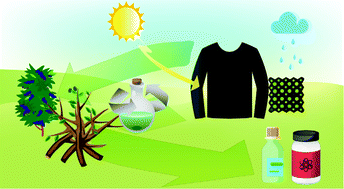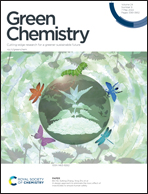Upcycling agro-industrial blueberry waste into platform chemicals and structured materials for application in marine environments†
Abstract
Blueberry pruning waste (BPw), sourced as residues from agroforestry operations in Chile, was used to produce added-value products, including platform chemicals and materials. BPw fractionation was implemented using biobased solvents (γ-valerolactone, GVL) and pyrolysis (500 °C), yielding solid fractions that are rich in phenols and antioxidants. The liquid fraction was found to be enriched in sugars, acids, and amides. Alongside, filaments and 3D-printed meshes were produced via wet spinning and Direct-Ink-Writing (DIW), respectively. For the latter purpose, BPw was dissolved in an ionic liquid, 1-ethyl-3-methylimidazolium acetate ([emim][OAc]), and regenerated into lignocellulose filaments with highly aligned nanofibrils (wide-angle X-ray scattering) that simultaneously showed extensibility (wet strain as high as 39%). BPw-derived lignocellulose filaments showed a tenacity (up to 2.3 cN dtex−1) that is comparable to that of rayon fibers and showed low light reflectance (RES factor <3%). Meanwhile, DIW of the respective gels led to meshes with up to 60% wet stretchability. The LCF and meshes were demonstrated to have reliable performance in marine environments. As a demonstration, we show the prospects of replacing plastic cords and other materials used to restore coral reefs on the coast of Mexico.



 Please wait while we load your content...
Please wait while we load your content...